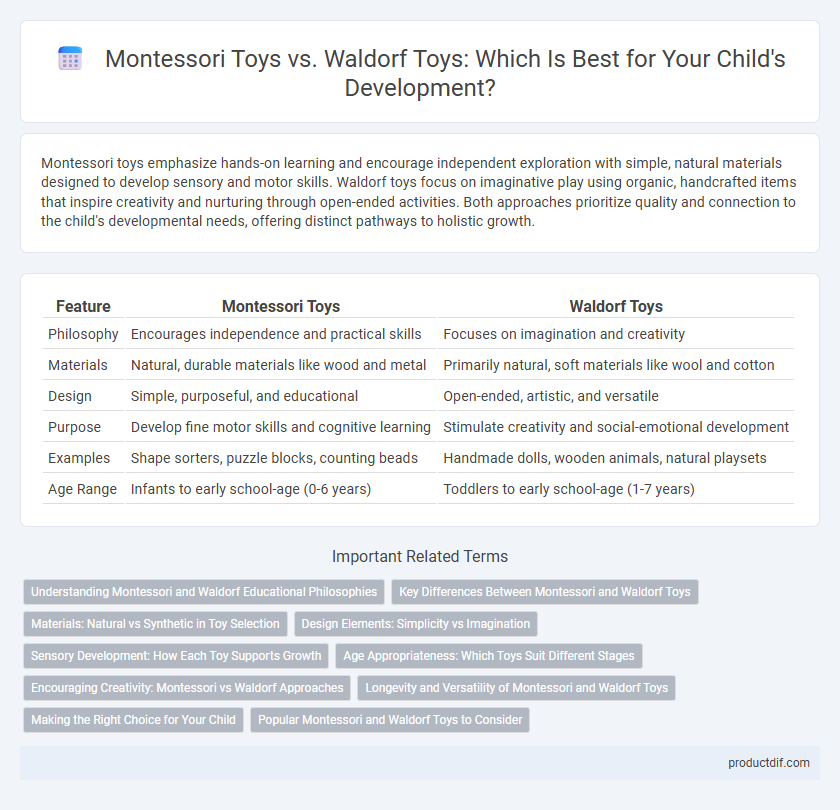Montessori toys emphasize hands-on learning and encourage independent exploration with simple, natural materials designed to develop sensory and motor skills. Waldorf toys focus on imaginative play using organic, handcrafted items that inspire creativity and nurturing through open-ended activities. Both approaches prioritize quality and connection to the child's developmental needs, offering distinct pathways to holistic growth.
Table of Comparison
| Feature | Montessori Toys | Waldorf Toys |
|---|---|---|
| Philosophy | Encourages independence and practical skills | Focuses on imagination and creativity |
| Materials | Natural, durable materials like wood and metal | Primarily natural, soft materials like wool and cotton |
| Design | Simple, purposeful, and educational | Open-ended, artistic, and versatile |
| Purpose | Develop fine motor skills and cognitive learning | Stimulate creativity and social-emotional development |
| Examples | Shape sorters, puzzle blocks, counting beads | Handmade dolls, wooden animals, natural playsets |
| Age Range | Infants to early school-age (0-6 years) | Toddlers to early school-age (1-7 years) |
Understanding Montessori and Waldorf Educational Philosophies
Montessori toys emphasize self-directed, hands-on learning with natural materials that promote sensory exploration and fine motor skills, reflecting the Montessori philosophy of fostering independence and practical life skills. Waldorf toys prioritize imaginative play and creativity, often made from natural elements like wood and wool, aligning with the Waldorf approach that values holistic development through storytelling and artistic expression. Both educational philosophies advocate for child-centered learning but differ in their methods: Montessori centers on structured, purposeful activities, while Waldorf encourages open-ended, imaginative experiences.
Key Differences Between Montessori and Waldorf Toys
Montessori toys emphasize educational value with a focus on developing fine motor skills, sensory exploration, and practical life activities through real-life materials like wooden blocks and puzzles. Waldorf toys prioritize imaginative play and creativity, often crafted from natural materials such as wool and wood, encouraging open-ended use and storytelling. The key difference lies in Montessori toys being structured to foster independent learning while Waldorf toys aim to inspire holistic development through artistic expression and fantasy.
Materials: Natural vs Synthetic in Toy Selection
Montessori toys prioritize natural materials such as wood, cotton, and metal, promoting sensory exploration and durability that align with educational principles. Waldorf toys emphasize sustainably sourced natural fibers like wool, silk, and untreated wood, fostering imaginative play through their tactile and organic qualities. In contrast, synthetic materials commonly found in other toys lack the sensory and ecological benefits valued in both Montessori and Waldorf approaches.
Design Elements: Simplicity vs Imagination
Montessori toys emphasize simplicity with natural materials, clean lines, and minimalistic designs to foster focus and concentration. Waldorf toys prioritize imagination, featuring handcrafted details, soft textures, and open-ended forms that encourage creative play. Both approaches use their distinct design elements to support child development through tactile and sensory experiences.
Sensory Development: How Each Toy Supports Growth
Montessori toys emphasize tactile and practical life skills, promoting fine motor development and sensory exploration through natural materials like wood and fabric, designed to foster independence and concentration. Waldorf toys incorporate organic shapes, natural fibers, and open-ended play, stimulating imagination and sensory integration by encouraging children to engage with textures, colors, and movement in a holistic way. Both approaches support sensory development uniquely, with Montessori focusing on structured learning experiences and Waldorf prioritizing creative, sensory-rich environments.
Age Appropriateness: Which Toys Suit Different Stages
Montessori toys are designed to support fine motor skills and sensory development, making them ideal for infants and toddlers aged 0-3 years, while Waldorf toys emphasize imaginative play and natural materials, suiting preschoolers aged 3-6 years. Montessori materials such as stacking blocks and sorting trays facilitate early cognitive tasks and independent learning, whereas Waldorf options like wooden figures and felt dolls encourage creativity and storytelling in slightly older children. Selecting toys aligned with developmental stages enhances learning outcomes and nurtures age-appropriate skills effectively.
Encouraging Creativity: Montessori vs Waldorf Approaches
Montessori toys emphasize open-ended, sensory-rich materials designed to foster independent problem-solving and real-world skills, encouraging creativity through exploration and manipulation. Waldorf toys prioritize natural, simple, and imaginative play with organic materials like wood and fabric, promoting creativity by inspiring storytelling and pretend play. Both approaches support creative development but differ in structure; Montessori focuses on purposeful learning with tangible objectives, while Waldorf nurtures free-form imagination and holistic child development.
Longevity and Versatility of Montessori and Waldorf Toys
Montessori toys are designed with durable, high-quality materials like natural wood, ensuring long-lasting use and the ability to grow with the child through various developmental stages. Waldorf toys, crafted primarily from natural fibers and untreated wood, emphasize open-ended play that encourages imagination and creativity, making them versatile across different ages and play scenarios. Both Montessori and Waldorf toys offer exceptional longevity and adaptability, allowing children to explore learning and creativity sustainably over time.
Making the Right Choice for Your Child
Choosing between Montessori toys and Waldorf toys depends on your child's developmental needs and learning style; Montessori toys emphasize hands-on, self-directed learning with a focus on fine motor skills and practical life activities, while Waldorf toys encourage creativity and imagination through natural materials and open-ended play. Montessori toys often include puzzle blocks, sorting frames, and sensory materials designed to promote cognitive and sensory development, whereas Waldorf toys feature wooden figures, natural fibers, and art supplies that nurture artistic expression and emotional growth. Selecting the right toy involves considering your child's temperament, interests, and the educational philosophy you want to support for fostering independence or imaginative play.
Popular Montessori and Waldorf Toys to Consider
Popular Montessori toys to consider include wooden blocks, shape sorters, and stacking rings, designed to enhance fine motor skills and encourage independent learning. Waldorf toys such as hand-carved animals, natural fiber dolls, and silk scarves promote creativity and imaginative play through their emphasis on natural materials and open-ended use. Both Montessori and Waldorf toys prioritize developmental benefits, but Montessori focuses on structured skill-building while Waldorf encourages artistic expression.
Montessori toys vs Waldorf toys Infographic

 productdif.com
productdif.com